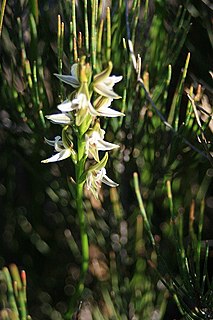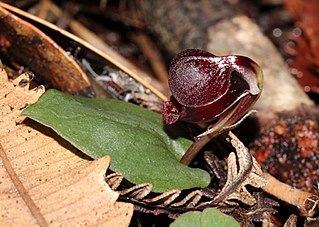
Acianthus fornicatus, commonly known as pixie cap, is a flowering plant in the orchid family Orchidaceae and is endemic to New South Wales and Queensland in Australia. It is a terrestrial herb with a single, heart-shaped leaf and up to ten translucent pinkish-red flowers and which is widespread and common in coastal and near-coastal areas.

Calochilus paludosus, commonly known as the red beard orchid or red beardie, is a species of orchid native to Australia and New Zealand. It has a single fleshy, light green leaf and up to nine greenish flowers with reddish stripes. The labellum has a dull red or coppery coloured beard and lacks the "eye" spots of other beard orchids.

Genoplesium fimbriatum, commonly known as the fringed midge orchid is a small terrestrial orchid found from southern Queensland to southern New South Wales. It has a single thin leaf and up to thirty green to brownish-green flowers with red stripes and a red-tipped labellum with hairy edges.

Pterostylis acuminata, commonly known as the sharp greenhood or pointed greenhood is a species of orchid endemic to eastern Australia. It has a rosette of leaves and a single green and white flower, leaning forward with a brown point on the end of the labellum.

Pterostylis squamata, commonly known as the southern rustyhood or ruddyhood, is a plant in the orchid family Orchidaceae and is endemic to south-eastern Australia. Flowering plants have up to ten translucent green flowers with reddish-brown markings and a hairy, insect-like labellum. Non-flowering plants have a rosette of four to eight egg-shaped leaves. This species is very similar to Pterostylis rufa which has a narrower labellum and other minor differences.

Pterostylis rufa, commonly known as the red rustyhood is a plant in the orchid family Orchidaceae and is endemic to south-eastern Australia. It has a rosette of leaves and up to fifteen bright reddish-brown flowers with translucent white "windows" and a dark brown, insect-like labellum. It occurs from southern Queensland to south-eastern South Australia.

Pyrorchis nigricans, commonly known as red beaks, is a species of orchid endemic to Australia and is found in all Australian states except Queensland and the Northern Territory. It has a single large, oval leaf and up to eight relatively large red and white flowers. It usually only flowers after hot fires.
Prasophyllum australe, commonly known as the southern leek orchid or austral leek orchid, is a species of orchid and is endemic to south-eastern Australia. It has a single tubular, green leaf and up to fifty scented, greenish-brown flowers with red stripes.
Prasophyllum gibbosum, commonly known as the humped leek orchid, is a species of orchid endemic to the south-west of Western Australia. It is a late-flowering leek orchid with a single smooth, tubular leaf and up to eighty or more purplish-red and white flowers with a smooth labellum. It is similar to P. cucullatum but that species has a frilly labellum, usually a shorter flowering stem and an earlier flowering period.

Acianthus caudatus, commonly known as the mayfly orchid, is a flowering plant in the orchid family Orchidaceae and is endemic to eastern Australia. It is a terrestrial herb with a single egg-shaped or heart-shaped leaf and up to nine dark purplish flowers with thin, spreading sepals and petals, often with a musty odour.

Prasophyllum striatum, commonly known as the streaked leek orchid or eastern hunchback orchid, is a species of orchid endemic to New South Wales. It has a single thin, tube-shaped leaf and up to ten greenish and whitish flowers with reddish or purplish stripes. It differs from other leek orchids in having a very thin leaf and prominently streaked flowers.
Genoplesium rufum, commonly known as the rufous midge-orchid, is a species of orchid endemic to New South Wales. It has a single thin, wiry leaf and up to twenty five drooping, pinkish or reddish flowers on a flowering stem which is fused to the lower part of the leaf. It was formerly thought to range from Queensland to South Australia and Tasmania but specimens in other states are now assigned to Genoplesium clivicola.
Corunastylis nigricans, commonly known as the Kangaroo Island midge orchid is a small terrestrial orchid endemic to South Australia. It has a single thin leaf and up to twenty five purplish brown flowers with a shiny, hairless, dark purplish labellum. It is sometimes confused with Genoplesium nigricans which has differently coloured flowers and a much wider distribution. It is regarded as a synonym of G. nigricans by the World Checklist of Selected Plant Families.
Genoplesium baueri, commonly known as the brittle midge orchid, is a small terrestrial orchid which is endemic to New South Wales. It has a single thin leaf and up to nine yellowish green to reddish brown flowers. It is mostly only found in coastal and near-coastal heath and woodland between Port Stephens and Ulladulla.
Microtis rara, commonly known as the scented onion orchid, is a species of orchid endemic to Australia, with the exception of the Northern Territory. It has a single hollow, onion-like leaf and up to fifty small green or yellowish-green, scented flowers. It is similar to Microtis oblonga and some authorities regard the two as being one species.

Chiloglottis diphylla, commonly known as the common wasp orchid, is a species of orchid endemic to Australia. It has two broad leaves and a single narrow, greenish brown to reddish flower with a black, insect-like callus covering the upper surface of the labellum.
Corybas fordhamii, commonly known as the banded helmet orchid or swamp helmet orchid, is a species of terrestrial orchid endemic to south-eastern Australia. It has an egg-shaped to heart-shaped leaf and a reddish to reddish purple flower which leans forward. It is similar to C. unguiculatis which does not grow in swamps and has a different labellum.

Corybas unguiculatus, commonly known as the small helmet orchid or pelicans, is a species of terrestrial orchid endemic to south-eastern Australia. It is a widespread, sometimes common but small orchid with a single leaf and a single reddish purple to reddish black flower.
Thelymitra media, commonly called the tall sun orchid, is a species of orchid that is endemic to eastern Australia. It has a single fleshy, channelled leaf and up to thirty blue flowers with darker streaks but without spots. The labellum is narrower than the other petals and sepals.
Thelymitra venosa, commonly known as the large veined sun orchid, is a species of orchid that is endemic to New South Wales. It has a single fleshy, channelled leaf and up to six relatively large, bright-blue flowers with darker veins. The arms on the side of the column are twisted and yellow, but not toothed at the tip. Unlike most other thelymitras, the flowers do not usually close on cloudy days.











